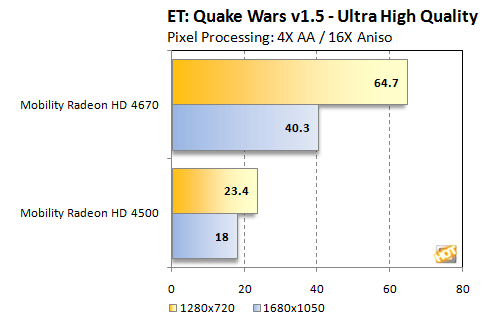ATI Mobility Radeon HD 4000 Series Preview
|
|
|
|
|
Enemy Territory: Quake Wars is Based on a radically enhanced version of id's Doom 3 engine and viewed by many as Battlefield 2 meets the Strogg, and then some. In fact, we'd venture to say that id took EA's team-based warfare genre up a notch or two. ET: Quake Wars also marks the introduction of John Carmack's "Megatexture" technology that employs large environment and terrain textures that cover vast areas of maps without the need to repeat and tile many smaller textures. The beauty of megatexture technology is that each unit only takes up a maximum of 8MB of frame buffer memory. Add to that HDR-like bloom lighting and leading edge shadowing effects and Enemy Territory: Quake Wars looks great, plays well and works high end graphics cards vigorously. The game was tested with all of its in-game options set to their maximum values with soft particles enabled in addition to 4x anti-aliasing and 16x anisotropic filtering. |

The results from our custom Enemy Territory: Quake Wars benchmark looks much like those from Left 4 Dead on the previous page. The more powerful Mobility Radeon HD 4670 puts up framerates more than twice as high as the 4500 series GPU.
|
|
|
We'd like to cover a few final data points before bringing this article to a close. Throughout all of our benchmarking and testing, we monitored how much power our test system was consuming using a power meter. Our goal was to give you an idea as to how much power each configuration used while idling and under a heavy graphics workload. Please keep in mind that we were testing total system power consumption at the outlet here, not just the power being drawn by the graphics cards alone.

Both of the experimental Mobility Radeon HD 4000 series graphics cards we tested consumed little power while idling--keep in mind they were tested in a Core i7-based desktop system and total idle power consumption was just slightly over 110 watts. Under load, the Mobility Radeon HD 4670 consumed an additional 33 watts and the 4500 series card and additional 21 watts. While those figures are somewhat higher than many integrated graphics solutions, they are relatively low for discreet graphics offerings.








